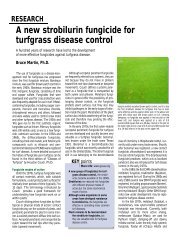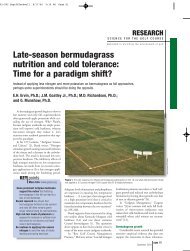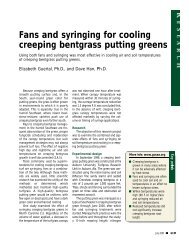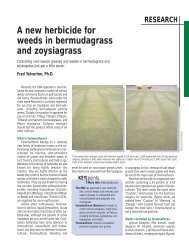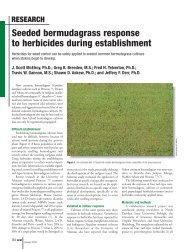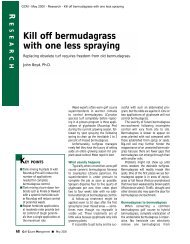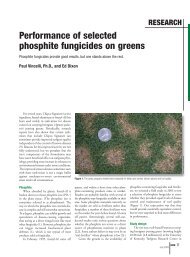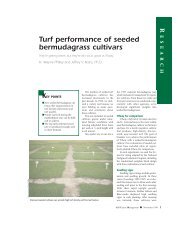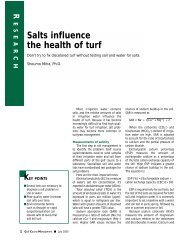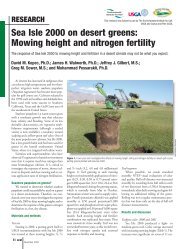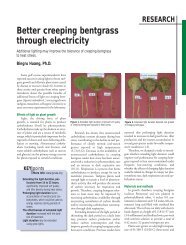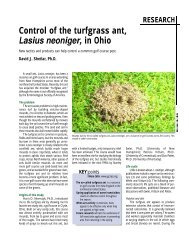Managing salts in soil and irrigation water - GCSAA
Managing salts in soil and irrigation water - GCSAA
Managing salts in soil and irrigation water - GCSAA
Create successful ePaper yourself
Turn your PDF publications into a flip-book with our unique Google optimized e-Paper software.
GCM - January 2001 - Research - <strong>Manag<strong>in</strong>g</strong> <strong>salts</strong> <strong>in</strong> <strong>soil</strong> <strong>and</strong> <strong>irrigation</strong> <strong>water</strong>R E S E A R C HPhotos courtesy of R.R. DuncanHigh rates of gypsum may be mixed <strong>in</strong>to sodic <strong>soil</strong>s to correct problems <strong>in</strong>troduced by poorquality<strong>water</strong>.Calcium can be added <strong>in</strong> formssuch as gypsum, limestone, dolomite,lime <strong>and</strong> so on. Gypsum is the mostcommon source, because it has littleeffect on the <strong>soil</strong> pH <strong>and</strong> has high <strong>water</strong>solubility. Gypsum is calcium sulfatedihydrate (CaSO 4 , 2H 2 O). Whengypsum comes <strong>in</strong> contact with <strong>soil</strong>solution, it generates calcium ions,which replace sodium from the <strong>soil</strong>exchange complex.The <strong>soil</strong> exchange complex has negativecharges, which are generated mostlyby clay <strong>and</strong> organic matter. Clay m<strong>in</strong>eralshave a negative charge caused bystructural substitution <strong>in</strong> their lattice(isomorphic substitution). Organicmatter, however, has negative charges onits surface as a result of dissociation ofthe carboxyl acid groups (-COOH) ofhumic <strong>and</strong> fulvic acids.The sodium sulfate (Na 2 SO 4 )formed <strong>in</strong> the <strong>soil</strong> must be removedfrom the <strong>soil</strong> profile by leach<strong>in</strong>g.Addition of polyvalent (more than onecharge) cations such as calcium <strong>and</strong>magnesium will flocculate the <strong>soil</strong>.These cations hold <strong>soil</strong> particles becausetheir charges form cationic bridges.Flocculation is a prerequisite for <strong>soil</strong>aggregation, <strong>and</strong> a well-aggregated <strong>soil</strong>forms <strong>water</strong>-stable aggregates. A wellaggregated<strong>soil</strong> has <strong>in</strong>creased porosity,aeration <strong>and</strong> <strong>in</strong>filtration.Gypsum requirementThe gypsum required by a particulargolf course depends on the quality of<strong>irrigation</strong> <strong>water</strong> <strong>and</strong> <strong>soil</strong>. The relativeamounts of sodium, calcium, magnesium,carbonate <strong>and</strong> bicarbonate determ<strong>in</strong>ethe amount of gypsum requiredto treat <strong>irrigation</strong> <strong>water</strong>.There are two ways to figurethe gypsum requirement: RSC <strong>and</strong>Eaton’s gypsum requirement (EGR).The RSC method takes <strong>in</strong>to accountthe amount of carbonate <strong>and</strong> bicarbonate<strong>in</strong> <strong>water</strong> compared to calcium<strong>and</strong> magnesium. It does not accountfor the sodium. Hence, it tends tounderestimate the gypsum requirement.This method is useful when theamount of carbonate <strong>and</strong> bicarbonateis high, but the amount of sodium islow compared to calcium <strong>and</strong> magnesium.The units must be <strong>in</strong> milliequivalentsper liter.Golf Course Management ■ January 2001 71



